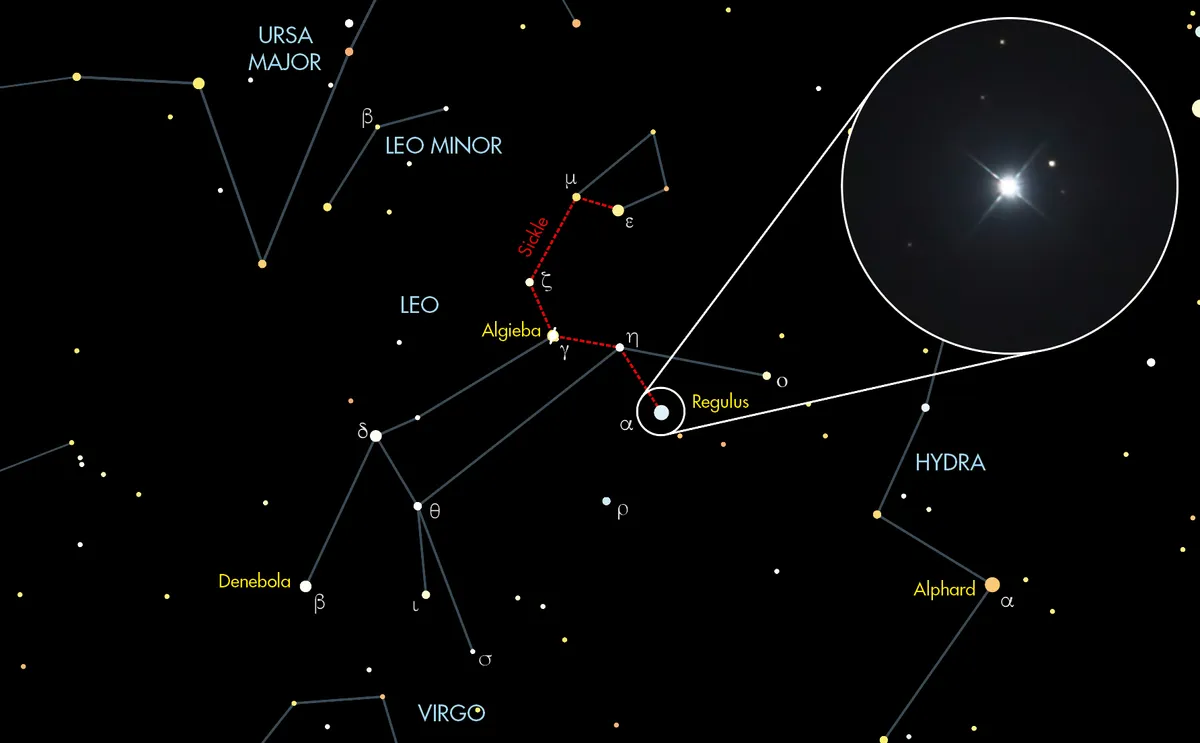The Snow Moon, the second full Moon of February, will be accompanied by a bright star called 'Regulus' on the evening of 12 February and into the early hours of 13 February.
A full Moon is always a beautiful sight, and there's something extra special about a meeting between the full Moon and a bright star or planet.

This is known in astronomy as a 'conjunction', which describes when two celestial objects appear next to each other in the sky.
So if you're looking up at the Snow Moon and wondering what the star next to it is, it's Regulus.
Let's explore the meeting in a little more detail.
For weekly stargazing advice, listen to our Star Diary podcast, sign up to the BBC Sky at Night Magazine e-newsletter and subscribe to our YouTube channel.
Snow Moon explained
What is the Snow Moon, and what's 'snowy' about it?!
Each of the monthly full Moons has acquired informal nicknames over the years, most of which reflect what's happening in nature during the month in question.
The Snow Moon is the name given to the full Moon in February, the second full Moon of the year and the last winter full Moon.
And that's where the name comes from: it's the full Moon visible during the month in which it's most likely to snow in the Northern Hemisphere.
It's worth pointing out that full Moon nicknames don't have any bearing on what that Moon will actually look like.
You won't find the Snow Moon looks any whiter or snowier than usual!
But you can find more advice on observing it by reading our guide on how to make the most of a full Moon.

Regulus
Bright star Regulus sits just below the Snow Moon on the evening of 12 February 2025.
Regulus – formally known as Alpha Leonis is one of the best stars to observe in the spring sky and can be seen with the naked eye.
It forms the base of the Sickle star pattern, which is located in the constellation Leo.
If you step outside on 11 February, the night before the Snow Moon rises, you'll also see Regulus close to the Moon.

However, on 11 February, Regulus won't be as close to the Moon as it is on 12 February, but observing the pair on 11 February and then the following evening is a nice exercise that shows how the Moon changes position relative to the stars and planets each night.
Regulus will be in largely the same position on the nights of 11–13 February (and, indeed, all week), but the Moon's position in the night sky changes night after night.
Head out on 11 February and note where Regulus is, relative to the Moon. The star is visible in the east around 20:00 UTC and the Moon will be high above it.
On 12 February, Regulus rises at the same time in the same direction, but now the Moon – this evening being the full Snow Moon – is much closer.
The Snow Moon and Regulus will get closer together throughout the evening of 12 February, being closest around 02:00 UTC on 13 February.

A matter of perspective
Of course, while Regulus and the Snow Moon look close together in the night sky, it goes without saying that they aren't actually close together!
To put it into perspective, Regulus is 79 lightyears away, meaning it takes light from the star 79 years to reach Earth.
The Moon, on the other hand, is about 1.3 lightseconds away, meaning it takes light from the Moon just over 1 second to reach Earth.
However, the night sky appears like a 2D dome above our heads, meaning stars and planets can appear close to one another, when in fact they are not.

Regulus and Snow Moon meeting explained
There's a reason why Regulus appears so close to the Snow Moon this week.
Regulus is found near the ecliptic, which is the imaginary path the Sun takes across the sky during the course of a day.
The planets are positioned around the ecliptic in the sky, and the Moon often crosses the ecliptic.
So because of Regulus's apparent position near the ecliptic, it can often be found close to the planets and the Moon.
Sometimes Regulus even undergoes a lunar occultation, when it seems to disappear behind the Moon.
If you observe or photograph Regulus and the Snow Moon, get in touch by emailing contactus@skyatnightmagazine.com

